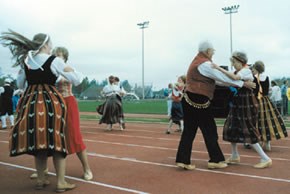By JUDI
KOSKI
Juhannus, as the summer solstice is called in Finnish, refers
to the Christian calendar's Feast of St. John the Baptist.
It is a holiday that is considered by Finns to be a quasi holy
day, kept apart for special occasions such as family reunions,
weddings and christenings.
The festival is celebrated on the Saturday that falls between
June 20th and June 26th. This year it was celebrated on June
21. Many of the customs associated with Midsummer's Day derive
from the pre-Christian festival of light and fertility that
marked the summer solstice.
Those of Finnish heritage, wherever they may reside, gather
together to feast, sing and dance. Homes are decorated with
flowers and birch branches. Men, women and children alike
participate in various events dressed in their colourful
regional national costumes.
The excitement builds when the kokko, a huge bonfire, is
fashioned into a distinct conical shape from old lumber. Close
to midnight the kokko is ceremoniously set on fire to the
endless delight of the spectators who linger far into the early
morning hours.
Juhannus is also Finland's Flag Day. According to the official
Juhannus rules, flags are raised at six in the evening on
Midsummer's Eve and lowered at 21 hours on the the evening of
the following day.
Join Sudbury.com+
- Messages
- Post a Listing
- Your Listings
- Your Profile
- Your Subscriptions
- Your Likes
- Your Business
- Support Local News
- Payment History
Sudbury.com+ members
Already a +member?
Not a +member?
Sign up for a Sudbury.com+ account for instant access to upcoming contests, local offers, auctions and so much more.
